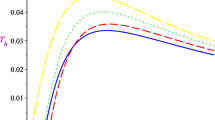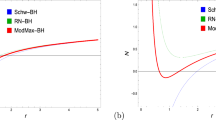Abstract
By using the horizon entropy, Hawking showed that a stable black hole will form inside a radiation cavity of finite energyE and small enough volume,V⩽V h(E). But two heuristic considerations seem to contradict this. First, a spontaneous fluctuation large enough to form a hole is so improbable that the chance of one developing even in 1010 years is negligible. Second, any such hole should not be in equilibrium, let alone stable; it should evaporate away again because the radiation, with typical wavelength ∼16 times larger than the hole, can hardly be accreted. Study of the combined accretion and evaporation resolves this difficulty. It confirms the prediction of stability and it does so without appeal to the concept of horizon entropy. A state of pure radiation is actually favored over one including a hole when 1⩾V/V h>0.2556, but the reverse holds for smaller cavity volumes. The horizon entropy of a black hole plays a natural role; it helps determine the system's evolution and equilibria through the condition that the total entropy of hole plus radiation always tends to increase. Using the known temperature of the hole and the fact (deduced from the accretion formula) that energy flows from the hot body to the cold, one easily inverts the reasoning to derive a unique value for the black-hole entropy.
Similar content being viewed by others
References
Christodoulou, D. (1970).Phys. Rev. Lett.,25, 1596.
Hawking, S. W. (1971).Phys. Rev. Lett.,26, 1344.
Bekenstein, J. D. (1974).Phys. Rev. D,9, 3292.
Hawking, S. W. (1974).Nature,248, 30.
Hawking, S. W. (1975).Commun. Math Phys.,43, 199.
Kundt, W. (1976).Nature,259, 30.
Wilkins, D. (1979).Gen. Rel. Grav.,11, 45.
Hawking, S. W. (1976).Phys. Rev. D, 13, 191.
Jeans, J. H. (1928).Astronomy and Cosmogony (Cambridge University Press, London), p. 38.
Wheeler, J. A. (1971). InCortona Symposium on Weak Interactions, ed. L. Radicati (Accademia Nazionale Dei Lincei, Rome), pp. 134–164.
Starobinskii, A. A. (1973).Sov. Phys.-JETP,37, 28.
Price, R. (1972).Phys. Rev. D,5, 2419, 2439.
Mashhoon, B. (1973).Phys. Rev. D,7, 2807.
Casimir, H. B. G. (1945).Rev. Mod. Phys.,17, 343.
Reif, F. (1965).Fundamentals of Statistical and Thermal Physics (McGraw-Hill Kogakusha, Tokyo), pp. 373–388.
Wald, R. M. (1975).Commun. Math. Phys.,45, 9.
Page, D. N. (1976).Phys. Rev. D,13, 198.
Author information
Authors and Affiliations
Rights and permissions
About this article
Cite this article
Wilkins, D. On the equilibrium of a black hole in a radiation-filled cavity. Gen Relat Gravit 11, 59–70 (1979). https://doi.org/10.1007/BF00756672
Received:
Issue Date:
DOI: https://doi.org/10.1007/BF00756672




